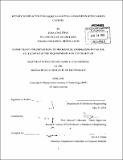Rotary bed reactor for chemical-looping combustion with carbon capture
Author(s)
Zhao, Zhenlong
DownloadFull printable version (16.17Mb)
Alternative title
Rotary bed reactor for CLC with carbon capture
Other Contributors
Massachusetts Institute of Technology. Dept. of Mechanical Engineering.
Advisor
Ahmed F. Ghoniem.
Terms of use
Metadata
Show full item recordAbstract
Chemical-looping combustion (CLC) is a novel and promising technology for power generation with inherent CO2 capture. Currently almost all the research has been focused on developing CLC based inter-connected fluidized bed reactors. A new rotating reactor concept for gas fueled CLC is proposed. In the reactor, a solid wheel rotates between the fuel and the air streams at the reactor inlet and exit. Two purging sectors are used to avoid the mixing between the fuel stream and the air stream. The rotating wheel consists of a large number of channels with copper oxide coated on the inner surface of the channels. The support material is boron nitride which has high specific heat and thermal conductivity. Gas flows through the reactor at elevated pressure and it is heated from 823K to 1245K by fuel combustion. The rotary reactor design for a thermal capacity of 1MW has been performed using a simplified model that was developed to predict the performances of the reactor. Preliminary analysis shows that both the fuel conversion efficiency and the carbon separation efficiency are close to unity. The wheel temperature fluctuation is small. There is great potential for further improvement of the construction and operating conditions, which will be followed up in the future.
Description
Thesis (S.M.)--Massachusetts Institute of Technology, Dept. of Mechanical Engineering, 2012. "June 2012." Cataloged from PDF version of thesis. Includes bibliographical references (p. 115-127).
Date issued
2012Department
Massachusetts Institute of Technology. Department of Mechanical EngineeringPublisher
Massachusetts Institute of Technology
Keywords
Mechanical Engineering.